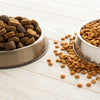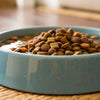How to Make Dry Dog Food from Scratch: A Complete Guide
- Houndsy
Table of Contents
- Introduction
- Why Make Homemade Dry Dog Food?
- Ingredients for Homemade Dry Dog Food
- Tips for Successful Homemade Dog Food Preparation
- Making Feeding Easier with Houndsy
- Conclusion
Introduction
Have you ever looked at the ingredient list on your dog's commercial kibble, only to be met with confusion and concern? You're not alone. Many pet owners are increasingly questioning the quality and nutritional value of the food they provide for their furry companions. A staggering statistic reveals that 60% of pet owners are now considering homemade diets for their pets, driven by a desire for healthier, fresher, and more transparent food options.
In this blog post, we aim to delve into the art and science of creating homemade dry dog food, particularly focusing on how to make dry dog food from scratch. By the end of this guide, you’ll have a comprehensive understanding of the benefits, essential ingredients, and step-by-step instructions to create nutritious kibble tailored to your dog's specific needs. Additionally, we’ll explore how the Houndsy Kibble Dispenser can enhance your homemade feeding experience, making it more convenient and enjoyable.
As we journey through this topic, we invite you to reflect on your current dog food routine. Are you satisfied with the quality of your dog’s diet? If you’re ready to elevate your pet’s feeding experience, then let’s explore how to make dry dog food from scratch!
Why Make Homemade Dry Dog Food?
The Benefits of Homemade Dog Food
Making your dog's food at home comes with a plethora of advantages:
- Control Over Ingredients: By preparing your dog’s meals yourself, you have complete control over what goes into their food. This means you can avoid fillers, preservatives, and artificial additives often found in commercial dog food.
- Freshness: Homemade food is made from fresh, high-quality ingredients, ensuring your dog receives the best nutrients possible.
- Customization: Each dog is unique, and their dietary needs can vary significantly. Homemade dog food allows you to tailor recipes to meet your pet's specific health requirements, age, and preferences.
- Quality Assurance: You can ensure that you're using human-grade ingredients, which are safer and more nutritious than some components found in commercial dog food.
- Health Benefits: Many pet owners report improvements in their dog's coat, energy levels, and overall health when transitioning to homemade diets.
Common Concerns
While there are numerous benefits, it's also crucial to address potential concerns:
- Nutritional Balance: Achieving the right balance of nutrients is essential. Dogs require a diet that includes proteins, fats, carbohydrates, vitamins, and minerals. Consulting with a veterinarian or a pet nutritionist can help ensure you’re meeting all of your dog’s dietary needs.
- Time and Effort: Preparing homemade dog food can be time-consuming, especially if you’re making it from scratch each time. However, many pet parents find meal prepping to be a rewarding investment in their dog's health.
Ingredients for Homemade Dry Dog Food
Essential Nutrients
To create a balanced dry dog food recipe, your ingredients should provide the following essential nutrients:
- Proteins: This should be the primary ingredient in your dog’s food. Options include lean meats (chicken, turkey, beef, or fish), eggs, or legumes.
- Carbohydrates: Whole grains (brown rice, oats, or quinoa) and vegetables (sweet potatoes, carrots, and peas) can serve as excellent sources of energy and fiber.
- Fats: Healthy fats from sources like fish oil or flaxseed oil are crucial for maintaining a shiny coat and overall health.
- Vitamins and Minerals: Incorporate fruits and vegetables to ensure your dog receives necessary vitamins and minerals. You may also consider adding a supplement recommended by your vet.
Sample Recipe for Homemade Dry Dog Food
Here’s a simple yet nutritious recipe to get you started on how to make dry dog food from scratch:
Ingredients:
- 2 cups brown rice
- 1 cup lentils
- 1/2 cup peas (fresh or frozen)
- 1 cup carrots (shredded)
- 1 pound ground turkey (or chicken)
- 1/4 cup olive oil
- 1/2 teaspoon salt (optional)
- 1 tablespoon parsley (chopped)
Instructions:
- Cook the Rice and Lentils: Combine brown rice and lentils in a pot with about 4 cups of water. Bring to a boil, then reduce heat and simmer until both are cooked (about 20-30 minutes).
- Prepare the Meat: In a separate pan, cook the ground turkey until it’s browned and cooked through.
- Combine Ingredients: In a large mixing bowl, combine the cooked rice and lentils with the ground turkey, peas, carrots, olive oil, and parsley. Mix well.
- Bake the Mixture: Preheat your oven to 350°F (175°C). Spread the mixture onto a lined baking sheet and flatten it out evenly. Bake for about 30-45 minutes until the mixture is firm.
- Cool and Cut: Once baked, let it cool before cutting it into bite-sized pieces. Store in an airtight container in the fridge for up to a week, or freeze portions for later use.
Adjusting the Recipe
Feel free to modify the recipe based on your dog’s preferences and dietary needs. You can swap proteins or add vegetables like spinach, green beans, or sweet potatoes. The key is to maintain a balance of nutrients while keeping it enjoyable for your furry friend.
Tips for Successful Homemade Dog Food Preparation
- Meal Prep: Consider cooking in bulk and storing your dog’s food in portions for easy access throughout the week. This can save you time and ensure your dog always has fresh food on hand.
- Storage: Use airtight containers for storing the food in the refrigerator or freezer. Properly stored, homemade kibble can last up to three months in the freezer.
- Monitor Your Dog’s Health: When transitioning to homemade food, pay attention to your dog’s health and digestion. Changes in diet can lead to shifts in bowel movements or energy levels.
- Consult a Vet: Regular vet check-ups are vital. They can provide insights into your dog’s health and help you fine-tune their diet over time.
Making Feeding Easier with Houndsy
At Houndsy, we understand that feeding your dog should be a joyful and straightforward experience. That’s why we created the Houndsy Kibble Dispenser, a beautifully designed product that makes mealtime easier and more enjoyable for both you and your dog.
Features of the Houndsy Kibble Dispenser
- Convenient Crank: Our ergonomic crank allows you to dispense the perfect portion without bending down, making feeding time less messy and more accessible.
- Large Capacity: With a storage capacity of 25–30 lbs, our dispenser means you can prepare larger batches of homemade kibble and store them effortlessly.
- BPA-Free Liner: The dispenser includes a BPA-free liner, ensuring your dog’s food remains fresh and safe.
- Auto-Locking Mechanism: Designed to keep curious pets (and toddlers) out, our dispenser's auto-locking feature prevents accidental dispensing.
Embracing the Houndsy Kibble Dispenser not only elevates your dog’s feeding experience but also complements your modern home decor with its mid-century design. For more information on the Houndsy Kibble Dispenser, visit our product page here.
Conclusion
Making dry dog food from scratch is not only a fulfilling endeavor but also a rewarding way to show love and care for your pet. By understanding the nutritional needs of your dog and using fresh, high-quality ingredients, you can create wholesome meals that contribute to their overall health and happiness.
As you embark on this journey of homemade dog food, remember that consistency is key. Experiment with different recipes, monitor your dog's reactions, and don’t hesitate to consult with a veterinarian to ensure you’re meeting their dietary needs.
To simplify your feeding routine even further, consider the Houndsy Kibble Dispenser. It’s designed to enhance the feeding experience, making it easier and more enjoyable for both you and your pooch.
FAQ
Q: Can I use any type of meat in my homemade dog food?
A: Yes, you can use various meats, including chicken, turkey, beef, and fish. Just ensure they are cooked thoroughly and free of bones.
Q: How do I know if my homemade dog food is balanced nutritionally?
A: Consult with a veterinarian or a pet nutritionist. They can help you understand the nutritional requirements and whether your recipes meet those needs.
Q: Can I include grains in my dog's diet?
A: Yes, dogs can benefit from healthy grains like brown rice and oats. However, some dogs may have specific dietary restrictions, so it's good to check with your vet.
Q: How often should I feed my dog homemade food?
A: The frequency depends on your dog’s age, size, and activity level. Generally, adult dogs are fed twice a day, while puppies may require three to four meals.
Q: Can I combine homemade food with commercial kibble?
A: Yes, you can mix the two, but be sure to monitor your dog’s digestion and overall health as you make any changes to their diet.
For more insights on enhancing your dog’s feeding experience, don't forget to explore our Houndsy Kibble Dispenser here. Let's feed our furry friends the best!












